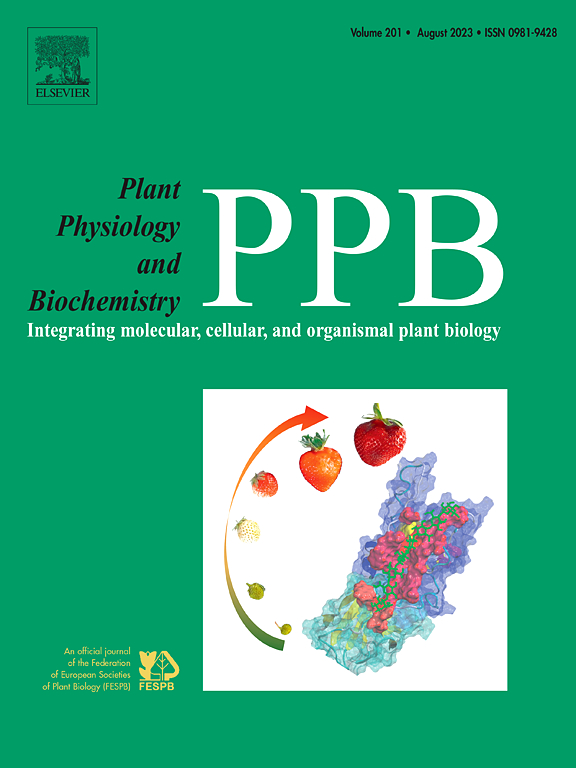富花青素油菜花青素谱及其转录调控
IF 5.7
2区 生物学
Q1 PLANT SCIENCES
引用次数: 0
摘要
在许多国家,芸苔作为一种可替代的生物燃料原料得到了广泛的应用,并且是一种众所周知的油籽和叶菜两用作物。紫色品种富含花青素,通常比较抢眼,也有益健康。采用超高高效液相色谱(UHPLC) -高分辨率质谱仪(HRMS)联用技术,对两个紫色品种(茎部呈明显紫色的ZJC和茎叶均呈紫色的ZJ)中11种不同酰基修饰的花青素3-糖苷-5-葡萄糖苷衍生物进行了表征。在ZJ中,主要花青素在C5位置被丙二醇基修饰,而在ZJC中没有发现这种修饰。在海苔(B. carinata)基因组中共鉴定出141个花青素生物合成基因(ABGs),并将这些基因与2个紫色品种和1个绿色品种叶片和茎皮的RNA-Seq比较转录组分析相结合,探讨了花青素积累的机制。提出了一种综合的花青素生物合成调控途径,该途径中的ABGs,特别是后期生物合成和转运基因,主要在色素组织的转录水平上受到调控。此外,R2R3 MYB转录因子BcaB05。MYB114通过与TT8和TTG1的相互作用,在芸苔属植物中被证实是花青素生物合成的关键和保守的调节剂。本研究为丰富花青素、提高园艺品质的石竹工程育种开辟了新的途径。本文章由计算机程序翻译,如有差异,请以英文原文为准。
Anthocyanin profiles and transcriptional control in anthocyanin-rich Brassica carinata
Brassica carinata has gained traction as an alternative biofuel feedstock in many countries, and serves as a well-known dual-purpose crop for both oilseed and leafy vegetable production. The purple varieties, which are rich in anthocyanins, are usually more eye-catching and beneficial to health. In this study, eleven cyanidin 3-glycoside-5-glucoside derivatives with different acyl modifications were characterized in two purple varieties of B. carinata (ZJC, which has an obvious purple stem, and ZJ, which has both purple stems and leaves) using an ultra-high performance liquid chromatography (UHPLC) system coupled with a high-resolution mass spectrometer (HRMS). In ZJ, the main anthocyanins are modified with a malonyl group at the C5 position, whereas such modifications are not found in ZJC. A total of 141 anthocyanin biosynthetic genes (ABGs) were identified in the B. carinata genome, and these genes were combined with the comparative transcriptome analysis based on RNA-Seq of leaves and stem peel from two purple varieties and one green variety to investigate the mechanisms underlying anthocyanin accumulation. A comprehensive synthetic and regulatory pathway for anthocyanin biosynthesis was proposed for B. carinata, and the ABGs in the pathway, particularly the late biosynthetic and transport genes, were predominantly regulated at the transcriptional level in pigmented tissues. Furthermore, the R2R3 MYB transcription factor BcaB05. MYB114 was verified as a crucial and conserved regulator of anthocyanin biosynthesis through its interactions with TT8 and TTG1 in Brassica species. This study opens new avenues for engineering anthocyanin-enriched B. carinata with improved horticultural quality.
求助全文
通过发布文献求助,成功后即可免费获取论文全文。
去求助
来源期刊
CiteScore
11.10
自引率
3.10%
发文量
410
审稿时长
33 days
期刊介绍:
Plant Physiology and Biochemistry publishes original theoretical, experimental and technical contributions in the various fields of plant physiology (biochemistry, physiology, structure, genetics, plant-microbe interactions, etc.) at diverse levels of integration (molecular, subcellular, cellular, organ, whole plant, environmental). Opinions expressed in the journal are the sole responsibility of the authors and publication does not imply the editors'' agreement.
Manuscripts describing molecular-genetic and/or gene expression data that are not integrated with biochemical analysis and/or actual measurements of plant physiological processes are not suitable for PPB. Also "Omics" studies (transcriptomics, proteomics, metabolomics, etc.) reporting descriptive analysis without an element of functional validation assays, will not be considered. Similarly, applied agronomic or phytochemical studies that generate no new, fundamental insights in plant physiological and/or biochemical processes are not suitable for publication in PPB.
Plant Physiology and Biochemistry publishes several types of articles: Reviews, Papers and Short Papers. Articles for Reviews are either invited by the editor or proposed by the authors for the editor''s prior agreement. Reviews should not exceed 40 typewritten pages and Short Papers no more than approximately 8 typewritten pages. The fundamental character of Plant Physiology and Biochemistry remains that of a journal for original results.

 求助内容:
求助内容: 应助结果提醒方式:
应助结果提醒方式:


